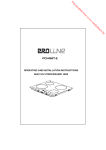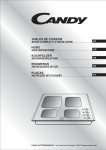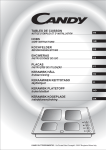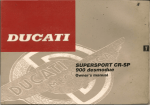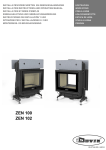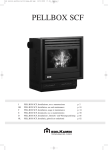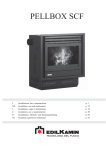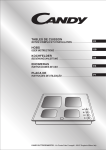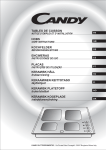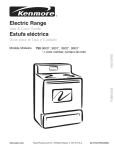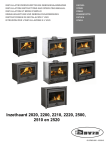Download Bedienungsanleitung
Transcript
BUILT-IN OVEN AND HOB USER'S MANUAL GB EINBAUOFEN UND KOCHFELD BEDIENUNGSANLEITUNG DE PCV 64 C PCE 64 X FCO 405 X FCO 105 X FCO 105 N FCO 105 W CANDY HOOVER GROUP S.R.L. • Via Privata Eden Fumagalli • 20047 Brugherio Milano Italy CONTENTS GB 1. Introduction Of Product ....................................................................4 2. General Warnings ..............................................................................5 2.1 Declaration Of Compliance................................................................5 2.2 Safety Hints .......................................................................................5 2.3 Installation .........................................................................................5 2.4 Fitting The Oven Into The Kitchen Unit..............................................5 2.5 Important............................................................................................5 2.6 Connecting To The Power Supply......................................................5 3. Oven Equipment ................................................................................6 4. Useful Tips..........................................................................................6 4.1 Shelf Safety System...........................................................................6 4.2 Grilling................................................................................................6 4.3 Cooking Time.....................................................................................6 4.4 Cleaning And Maintenance ...............................................................6 4.5 Service Centre...................................................................................6 5. Preparation For Installation And Use...............................................7 5.1 Choosing A Place For The Oven........................................................7 5.2 Oven And Hob Installation .................................................................7 5.2.1. Installation Steps ...................................................................8 5.2.2. Fixing the solid hotplate hob ..................................................8 5.2.3. Fixing the vitroceramic hob.....................................................8 5.2.4. Fixing the oven.......................................................................8 5.2.5. Warning..................................................................................8 5.3 Wiring And Safety Of The Built-in Combined Oven............................9 5.4 Vitroceramic Hob Without Control Knob “PVS”..................................9 6. Using The Oven................................................................................10 6.1 Control Panels..................................................................................10 6.2 Using The Cooktop Burners.............................................................11 6.2.1. Warnings ..............................................................................11 6.3 Using The Oven ...............................................................................11 6.4 Functions .........................................................................................12 7. Cleaning And Maintenance..............................................................13 7.1 General.............................................................................................13 7.2 Cleaning The Oven..........................................................................13 7.3 Cleaning The Solid Hotplate Hob.....................................................13 7.4 Cleaning The Vitroceramic Hob.......................................................13 7.5 Maintenance ....................................................................................13 8. Service And Transportation............................................................13 8.1 Requirements Before Contacting To Service...................................13 8.2 Information Related To Transport ....................................................13 INHALT DE 1. Ihr Neues Haushaltsgerät ...............................................................14 2. Allgemeine Hinweise .......................................................................15 2.1 Konformitätserklärung .....................................................................15 2.2 Sicherheitshinweise.........................................................................15 2.3 Installation........................................................................................15 2.4 Einbau In Den Schrank....................................................................15 2.5 Wichtig.............................................................................................15 2.6 Elektrischer Anschluß.......................................................................15 3. Ofenausstattung ..............................................................................16 4. Einige Nützliche Hinweise ..............................................................16 4.1 Kippgesicherte Gitterroste ...............................................................16 4.2 Grillen ..............................................................................................16 4.3 Garzeiten .........................................................................................16 4.4 Reinigung Und Wartung ..................................................................16 4.5 Technischer Kundendienst ..............................................................16 5. Vorbereitungen Für Installation Und Gebrauch ...........................17 5.1 Der Richtige Platz Für Ihren Ofen ...................................................17 5.2 Ofen - Und Kochfeldinstallation .......................................................17 5.2.1. Installationsschritte .............................................................18 5.2.2. Kochplatten-Kochfeld fixieren ..............................................18 5.2.3. Glaskeramisches Kochfeld fixieren......................................18 5.2.4. Ofen fixieren ........................................................................18 5.2.5. Warnung ..............................................................................18 5.3 Verkabelung Und Sicherheit Einbauofen.........................................19 5.4 Ceranfelder Ohne Bedienelemente “PVS” ......................................19 6. Bedienung .......................................................................................20 6.1 Bedienfeld .......................................................................................20 6.2 Kochplatten Verwenden ..................................................................21 6.2.1. Warnhinweise .......................................................................21 6.3 Ofen Verwenden..............................................................................21 .........................................................................................22 6.4 Funktionen 7. Reinigung Und Wartung .................................................................23 7.1 Allgemein .........................................................................................23 7.2 Ofen Reinigen..................................................................................23 7.3 Kochplatten-kochfeld Reinigen........................................................23 7.4 Glaskeramisches Kochfeld Reinigen ..............................................23 7.5 Wartung ...........................................................................................23 8. Service Und Transport ....................................................................23 8.1 Bevor Sie Sich An Den Kundendienst Wenden ...............................23 8.2 Hinweise Zum Transport..................................................................23 1. INTRODUCTION OF PRODUCT Figure 1 Figure 2 MAIN PARTS Table 1 1. Control Panel 2. Oven Door Handle 3. Oven Door 4. Tray 5. Lower Heating Element 6. Upper Heating Element 7. Grid 8. Racks Hob - Oven Combination Possibility FCO 105 W FCO 105 N FCO 105 C FCO 405 X PCV 64 C √ √ √ √ PCE 64 X √ √ √ √ VITROCERAMIC HOB: PCV 64 C 1200 W 1700 W VITROCERAMIC HOB: PCE 64 X 2100 W 1200 W 1500 W 1500 W 2000 W 1000 W Figure 3 Figure 4 MAIN PARTS MAIN PARTS 1. Ø 190 Radiant Zone (1700W) 2. Ø 155 Radiant Zone (1200W) 3. Ø 220 Radiant Zone (2100W) 4. Ø 155 Radiant Zone (1200W) 5. Vitroceramic Surface 6. Lower Casing 1. Ø 180 Rapid Solid Hotplate (2000W) 2. Ø 145 Solid Hotplate Burners (1500W) 3. Ø 180 Solid Hotplate Burners (1500W) 4. Ø 145 Solid Hotplate Burners (1000W) 5. Cooktop 6. Lower Casing 04 GB 2. GENERAL WARNINGS Thank you for choosing one of our products. To get the most out of your oven we recommend that you: • Read the notes in this manual carefully: they contain important instructions on how to install, use and service this oven safely. • Keep this booklet in a safe place for easy, future reference. All accessible parts are hot when the appliance is in operation, take care to not touch these elements. When the oven is first switched on it may give out acrid smelling fumes. This is because the bonding agent for insulating panels around the oven has been heated up for the first time. This is a completely normal, if it does occur you merely have to wait for the fumes to clear before putting the food into the oven. An oven by its very nature becomes very hot. Especially the glass of the oven door. Do not allow children to go near the oven when it is hot, especially when the grill is on. 2.1 DECLARATION OF COMPLIANCE 2.4 FITTING THE OVEN INTO THE KITCHEN UNIT The parts of this appliance that may come into contact with foodstuffs comply with the provisions of EEC Directive 89/109. Appliance complies with European Directives 73/23/EEC and 89/336/EEC, replaced by 2006/95/EC and 2004/108/EC, and subsequent amendments. When you have unpacked the oven, make sure that it has not been damaged in any way. If you have any doubts at all, do not use it: contact a professionally qualified person. Keep packing materials such as plastic bags, polystyrene, or nails out of the reach of children because they are dangerous for children. Fit the oven into the space provided in the kitchen unit; it may be fitted underneath a work top or into an upright cupboard. Fix the oven in position by screwing into place.(Figure 11). To locate the fixing holes, open the oven door and look inside.To allow adequate ventilation, the measurements and distances indicated in the diagram on last page must be adhered to when fixing the oven. Note: For ovens that are combined with a hob unit the instructions contained in the manual for the hob unit must be followed. 2.5 IMPORTANT 2.2 SAFETY HINTS If the oven is to work properly, the kitchen housing must be suitable. The panels of the kitchen unit that are next to the oven must be made of a heat resistant material. Ensure that the glues of units made of veneered wood can withstand temperatures of at least 120 °C. Plastics or glues that cannot withstand such temperatures will melt and deform the unit. Once the oven has been lodged inside the unit, the electrical parts must be completely insulated. This is a legal safety requirement. All guards must be firmly fixed into place so that it is impossible to remove them without using special tools. Remove the back of the kitchen unit to ensure an adequate current of air circulates around the oven. The hob must have a rear gap of at least 45 mm. •The oven must be used only for the purpose for which it was designed: it must only be used for cooking food. Any other use, e.g. as a form of heating, is an improper use of the oven and is therefore dangerous. •The manufacturers cannot be held responsible for any damage caused by improper, incorrect or unreasonable use. When using any electrical appliance you must follow a few basic rules. – Do not pull on the power cable to remove the plug from the socket. – Do not touch the oven with wet or damp hands or feet. – Do not use the oven unless you are wearing something on your feet. – Do not allow children or irresponsible people to use the oven unless they are carefully supervised. – It is not generally a good idea to use adapters, multiple sockets for several plugs and cable extensions. – If the oven breaks down or develops a fault switch it off at the mains and do not touch it. •If the cable is at all damaged it must be replaced promptly. When replacing the cable, follow these instructions. Remove the power cable and replace it with one of the H05RRF, H05VV-F, H05V2V2-F type. The cable must be able to bear the electrical current required by the oven. Cable replacement must be carried out by properly qualified technicians. The earthing cable (yellowgreen) must be 10 mm longer than the power cable. Use only an approved service centre for repairs and ensure that only original parts are used. If the above instructions are not adhered to the manufacturers cannot guarantee the safety of the oven. •This appliance is not intended for use by persons (including children) with reduced physical, sensory or mental capabilities, or lack of experience and knowledge, unless they have been given supervision or instruction concerning use of the appliance by a person responsible for their safety. •Children should be supervised to ensure that they do not play with the appliance. 2.6 CONNECTING TO THE POWER SUPPLY Plug into the power supply. Ensure first that there is a third contact that acts as earthing for the oven. The oven must be properly earthed. If the model of oven is not fitted with a plug, fit a standard plug to the power cable. It must be able to bear the power supply indicated on the specifications plate. The earthing cable is yellowgreen. The plug must be fitted by a properly qualified person. If the socket and the plug are incompatible the socket must be changed by a properly qualified person.A properly qualified person must also ensure that the power cables can carry the current required to operate the oven. An ON/OFF switch may also be connected to the power supply. The connections must take account of the current supplied and must comply with current legal requirements. The yellow-green earthing cable must not be governed by the ON/OFF switch. The socket or the ON/OFF switch used for connecting to the power supply must be easily accessible when the oven has been installed. Important: During installation, position the power cable in such a way that it will not be subjected to temperatures of above 50°C at any point. The oven complies with safety standards set by the regulatory bodies. The oven is safe to use only if it has been adequately earthed in compliance with current legal requirements on wiring safety. You must ensure that the oven has been adequately earthed. The manufacturers cannot be held responsible for any harm or injury to persons, animals or belongings caused by failure to properly earth the oven. WARNING: the voltage and the supply frequency are showed on the rating plate (figure 21). The cabling and wiring system must be able to bear the maximum electric power required by the oven. This is indicated on the specifications plate. If you are in any doubt at all, use the services of a professionally qualified person. 2.3 INSTALLATION Installation is the customer’s responsibility. The manufacturers have no obligation to carry this out. If the assistance of the manufacturer is required to rectify faults arising from incorrect installation, this assistance is not covered by the guarantee. The installation instructions for professionally qualified personal must be followed. Incorrect installation may cause harm or injury to people, animals or belongings. The manufacturer cannot be held responsible for such harm or injury. 05 GB 3. OVEN EQUIPMENT (according to the model) 4. USEFUL TIPS It is necessary to do an initial cleaning of the equipment before the first use of each of them.Wash them with a sponge. Rinse and dry off. The simple shelf can take moulds and dishes. The tray holder shelf is especially good for grilling things. Use it with the drip tray. 4.1 SHELF SAFETY SYSTEM The oven features a new shelf safety system. This allows you to pull out the oven shelves when inspecting the food without danger of food spillages or shelves falling accidentally out of the oven. To remove the shelves pull out and lift. The special profile of the shelves means they stay horizontal even when pulled right out. There is no risk of a dish sliding or spilling. Figure 9 4.2 GRILLING Figure 5 Grilling makes it possible to give food a rich brown colour quickly. For browning we recommend that you insert the grill onto the fourth level, depending on the proportions of the food (see fig. page 12). Almost all food can be cooked under the grill except for very lean game and meat rolls. Meat and fish that are going to be grilled should first be lightly doused with oil. The drip tray catches the juices from grilled foods. It is only used with the Grill, Rotisserie, or Fan Assisted Grill ; remove it from the oven for other cooking methods. Never use the drip tray as a roasting tray as this creates smoke and fat will spatter your oven making it dirty. 4.3 COOKING TIME Figure 6 For recommended cooking times and temperatures the first time you use the oven, refer to the tables on page 12. You may then wish to vary these times and settings in the light of your own experience. The pizza set is designed for pizza cooking. In order to obtain the best results the set must be used together with Pizza function. 4.4 CLEANING AND MAINTENANCE Never use a steam or high pressure spray to clean the appliance. Never use abrasive cleaners, wire wool or sharp objects to clean the glass oven door. Clean the stainless steel and enamelled surfaces with warm, soapy water or with suitable brand products. On no account use abrasive powders that may damage surfaces and ruin the oven’s appearance. It is very important to clean the oven each time that it is used. Melted fat is deposited on the sides of the oven during cooking. The next time the oven is used this fat could cause unpleasant odours and might even jeopardise the success of the cooking. Use hot water and detergent to clean; rinse out thoroughly. To make this chore unnecessary all models can be lined with catalytic self-cleaning panels: these are supplied as an optional extra (see the section SELF-CLEANING OVEN WITH CATALYTIC LINING). Use detergents and abrasive metal pads like «brillo pads» for the stainless steel grills. The glass surfaces as the top, oven door and warming compartment door must be cleaned when they are cold. Damage that occurs to them because this rule was not adhered to are not covered by the guarantee. To replace the interior light: • switch off the mains power supply and unscrew bulb. Replace with an identical bulb that can withstand very high temperatures Figure 7 The tray holder The tray holder shelf is ideal for grilling. Use it in conjunction with the drip tray. A handle is included to assist in moving the both accessories safely. Do no leave the handle inside the oven. Figure 8 4.5 SERVICE CENTRE Before calling the Service Centre If the oven is not working, we recommend that: you check that the oven is properly plugged into the power supply. If the cause of the fault cannot be detected: disconnect the oven from the mains, do not touch the oven and call the after sales service. Before calling the Service Centre remember to make a note of the serial number on the specifications plate (see fig. page 13). The oven is supplied with a guarantee certificate that ensures that it will be repaired free of charge by the Service Centre 06 GB 5. PREPARATION FOR INSTALLATION AND USE Manufactured with best quality parts and materials, this modern, functional and practical oven will meet your needs in all respects. Make sure to read this manual to obtain successful results and not to experience any problems in the future. The information given below contain rules that are necessary for correct positioning and service operations. They should be read without fail especially by the technican who will install the appliance. 5.2 OVEN and HOB INSTALLATION Figure 11 - Regular Installation of Oven 5 10 m m 5 80m m 40mm 5.1 CHOOSING A PLACE FOR THE OVEN There are several points to pay attention to when choosing a place for your oven. Make sure to take into account our recommendations below in order to prevent any problems and dangerous situations, which might occur later! • When choosing a place for the oven, attention should be paid that there are no flammable or combustible materials in the close vicinity, such as curtains, oilcloth etc., Which quickly catch fire. • Furnitures surrounding the oven must be made of materials resistant to temperatures above 50C°. • Required changes to wall cabinets and exhaust fans above the built-in combined product as well as minimum height from the oven board are show in Figure 10. Accordingly, the exhaust fan should be at a minimum height of 65 cm from the worktop. If there is no exhaust fan the height should not be less than 70 cm. B A Table 2 BUILDING-IN HOBS VITRO 4E A 560 560 B 490 480 4x3.5x25 Figure 10 07 GB 5.2.1. Installation Steps 1.Place the hob into the opening on worktop. The size of opening is given in Figure 11. Fordetails, see the headings either Fixing the solid hotplate hob or Fixing the vitroceramic hob. .2.Connect the hob to the oven using the the plug given on the hob. The socket for plug is placed on the rear panel of oven. 3.Connect the oven to the electrical supply. 4.Place the oven into its built-in niche. Either placement in Figure 11 is applicable depending on the size of cabinet opening. For details, see the heading Fixing the oven. 5.2.4. Fixing the oven Fit the oven into the space provided in the kitchen unit; it may be fitted underneath a work top or into an upright cupboard. Fix the oven in position by screwing into place, using the two fixing holes in the frame. To locate the fixing holes, open the oven door and look inside. To allow adequate ventilation, the measurements and distances indicated in the diagram on last page must be adhered to when fixing the oven. ENG 5.2.2. Fixing the solid hotplate hob The dimensions and material of the cabinet in which the oven will be installed must be correct and resistant to increases in temparature. In a correct installation, contact with electrical or insulated parts must be prevented. Insulating parts need to be fitted in a way to ensure that they cannot be removed by using any kind of tool. Installing the appliance in the close vicinity of a refrigerator or a deep-freezer is not recommended. Otherwise, the performance of the above-mentioned appliances will be negatively affected due to emanating heat. In order to prevent leakage of any liquids on the counter, a special sealing putty is supplied together with your oven. Apply this putty around the clearance on the kitchen counter. Extend the fivepiece putty by stretching and apply it around the clearance. Place the hob on it, as indicated in the Figure 11. Make sure to fit all four clamps by using one screw for each as shown in the Figure 12. In case the thickness of the kitchen counter is less than 40mm, use the clamp as shown in the Figure 14. After fitting your hob into its place, neatly remove the excess sealing putty around the sides with the help of a spatula Figure 13. 5.2.5. Warning Warning regarding the installation of built-in oven without cooling fan. h>40mm Prior inserting the oven, it is necessary to remove the rear kitchen element panel in the area of the oven opening. Equally, the front part of the element must have an opening. h Figure 12 60 cm2 h<40mm 120 cm h 2 Figure 13 Figure 14 5.2.3. Fixing the vitroceramic hob 240 cm2 • Apply the one-sided self-adhesive sealing tape supplied all the way round the lower edge of the cooking surface along the outer edge of the glass ceramic panel. Do not stretch it. • Screw the 4 worktop mounting brackets on the side walls of product. • Place the hob into the opening on the worktop. Figure 16 Worktop mounting braket 5 Figure 15 08 GB 180 cm2 5.3 WIRING AND SAFETY OF THE BUILT-IN COMBINED OVEN 5.4 VITROCERAMIC HOB WITHOUT CONTROL KNOB “PVS” •Before making the connection, make sure that the installation is protected by a suitable fuse, see table, and that it is fitted with wires of a large enough section to supply the appliance normally. •Turn over the hob, glass side against the work top, taking care to protect the glass. •Open the cover in the following sequence; Figure 17 Figure 18 Connection to the electrical circuit, on the oven or glass ceramic hob, should be made via the oven. For this reason, it is important that the instructions given in the oven instructions booklet are followed carefully. The ceramic hob without controls "PVS", has been developed to be used only in conjunction with specific separate control units or built in ovens with integral hob controls. A detailed table (supplied with ovens with integral hob control or with independent control units) shows clearly how the hobs are to be connected to the specified units. Under no circumstances must the hob be connected with any other control or oven not specified in the list. To proceed with the connection, it is necessary to joint male connectors 1 and 2 of the hob with the “female” connectors 3 of the oven or of the control panel. Figure 19 INSTALLATION WITH OVEN HOB To release the power supplying cord. • Remove the screws retaining the terminal block which contains the shunt bars and the conductors of the supply cord, • Pull out the supply cord. OVEN •Operations to be carried out to make a mew connection: -Choose the power supply cable in accordance with the recommendations in the table. -Pass the power supply cable in to the clamp. Shunt -Strip the end of each conductor of the supply cord on a 10 mm length, by taking in account the requested length of the cord for the connection to the terminal block. -According to the installation and with the help of shunt bars which you should have recovered in the first operation, fix the conductor as shown on the chart. -Fix the cover. -Screw the cable clamp. Figure 20 Note: make sure the terminal board screws are tight. 3 3 4 L1 2 4 L1 2 5 1 N 5 1 L2 T T 3 L1 4 2 L2 5 1 L3 4 5 1 T L1: Phase L1: Phase L1: Phase L1: Phase shunt 3-4 and shunt 3-4 L2: Phase shunt 4-2 shunt 4-2 L2: Phase L3: Phase N: Neutral L2: Phase shunt 2-5 N: Neutral shunt 1-5 shunt 1-5 L3: Phase shunt 1-5 T: Earth T: Earth T: Earth T: Earth THREE-PHASE THREE-PHASE THREE-PHASE 220 - 240 V2~ 380 - 415 V2~ 380 - 415 V3~ 380 - 415 V3N~ VOLTAGE 25 A 2 x 16 A 3 x 16 A 3 x 16 A FUSE 2 2 2 2 instructon booklet concerned. This connection can be made before or after the oven is screwed into place. 2 shunt 3-4 and MONOPHASE Bult-in oven "apertures" : Refer to the Figure 22 3 L1 L2 L3 N T 550x10 3 G 2.5 mm 3 G 2.5 mm 4 G 1.5 mm 5 G 1.5 mm CABLE-SECTION HO5VV-F HO5VV-F HO5VV-F HO5VV-F CABLE-TYPE Figure 21 09 GB 22 mini • Unscrew the cable clamp “1”, • Find the two tabs located on the sides, • Put the blade of a flat screw-driver in front of each tab “2” e “3”, push in and press, • Remove the cover. 6. USING THE OVEN 6.1 CONTROL PANELS Electric Burner Control Light Oven Thermostat Light Figure 23 Oven Function Control Knob Electric Burner Control Knob Figure 24 10 GB Oven Thermostat Knob 6.2 USING THE COOKTOP BURNERS The hob part of the product is controlled via the on the control panel (Figure 25). Stage "0" means off position. The remaining 6 stages indicate the following types of use: • In order to prevent waste of energy, the pots to be used should not be smaller or larger than the burner surfaces. • Take the necessary measures so that small children will not come close to the burner surface in any way, as it will be hot in operating position. • Due to the flammable nature of hot oil, operations such as frying should be performed with the container lids closed. • Do not cut anything, bread etc., on the glass. Do not use pots with aluminium bottoms. Avoid placing too heavy materials on your hob. • Do not place materials such as plastic, aluminium on the ceramic glass surface. If for any reason there should be a plastic or aluminium material melted on it, clean it up with a spatula immediately. • Do not wipe the ceramic surface with materials such as dish cloth or sponge. Residues of detergents may lead to fire as well as cause the glass colour to fade. 1.......Heat Maintenance Position 2.3....Heating in Low Temperature Position 4.5.6.Cooking,Frying and Boiling Position Figure 25 The upper part of the Solid hotplate is covered with a heatresistant protective material. At first run, in order to harden the protective layer by burning it, bring the electric burner button to position “3” and run the burner for 5 minutes. While using the electric burners, attention should be paid that the pots used have smooth even bottoms. You can obtain maximum performance from your hob if you use pots with suitable diameters and even bottoms. Using pots with small diameters on burners with large diameters is not recommended. Because that will cause heat loss and lead to a waste of energy. YES NO NO NO 6.3 USING THE OVEN First, you need to adjust the oven function (Figure 27 and 28) and then set the oven temperature to desired value (Figure 29). Otherwise, the oven will not operate. When the temperature inside your oven reaches the value you set, the thermostat will cut the circuit and the thermostat light will go off. When the temperature falls below the set value, the thermostat will again be turned on and the thermostat light will be on. NO Figure 26 Resistance of the vitroceramic glass to heat and extreme changes of temperature is very high. A redness will be noticed on the heated surface with time. When any heating unit is run, you may hear a weak sound; this is normal and it has to do with the technical structure of the system. It does not pose any problems in terms of quality. In case sharpedged pots should rub against or roughly placed on the vitroceramic glass, the sur face may become damaged. It is recommended that you pay attention to this. Figure 27 Figure 28 Figure 29 Symbol Table 3 EXPLANATION Energy Class according to CENELEC EN 50304 Light The oven light, red warning light and the fan will be turned on. Performs the function of defrosting the frozen foods. 6.2.1. Warnings B (convection) for FCO 405 X FCO 105 X FCO 105 N FCO 105 W The oven’s thermostat and warning light, the fan and the turbo B (forced air)only heater will be switch on. for FCO 405 X The oven’s thermostat and warning light, the grill heater function will be switched on. The oven’s thermostat and warning light, the upper heating element, the grill heater, the fun function will be switched on. The oven’s thermostat and warning light and the lower and upper heating elements will be switched on. • When a cooktop burner knob is brought to another position than the ‘’0’’ position, the operation light will be on. • Use only pots which fit the burner diameter. • Before placing the pot on the burner, be sure that its bottom is not wet. • Never operate a cooktop burner while empty. Pot temperature may be high when the appliance is in use. Therefore, it is recommended that you keep children and pets away from the hob both during and after operation. • In case you notice any crack on the ceramic glass , it must be immediately switched off and replaced by the Authorised Service. • After use (in order to ensure its continuously effective operation and long service life), hotplates need to be thoroughly cleaned using appropriate cleaning materials. In order to prevent any formation of rust and preserve their initial appearance, it is recommended to clean the hotplates rubbing them with a piece of cloth that is slightly damped by oil. Never use steam cleaners. The oven’s upper heating element will be switched on. The oven’s lower heating element will be switched on. 11 GB 6.4 FUNCTIONS Grill Function Availability of the functions explained below vary depending on the product model. This function is used for grills, roast chicken and roast on skewer. For grills; put the foods on the grid , and on the highest rack. After placing the oven tray on the third . Rack, you can start the grill operation. The tray placed on the thrid rack will ensure that the oil dropping from the foods will be collected. When grilling, the oven door must be closed and the oven temperature should be adjusted to 190° C. Turn your oven’s thermostat knob so it will point to this temperature value. After a preheating period of 5 minutes, put your foods into the oven. After the cooking, turn off the oven function control knob and the thermostat. Take the cooked/baked food out of the oven, place it on a safe place and ensure that the oven completely cools off by keeping the oven door open. As the oven will be hot, stay away from the oven and keep your children away. Defrost Function You can start the defrost operation by putting the frozen food into the oven and bringing the button to the indicated mark. This function does not cook/bake the food; it only helps defrost it within a short time. Put the food to be defrosted on the wire rack that you will place on the third rack support from the bottom (Figure 30). To collect the water to accumulate due to the melting ice, insert an oven tray into the lower rack. Grill and Fan Function At this function; ensuring complete frying by working together the fan, grill and upper heating element perform the operation. For grills; put the foods on the grid, and place the grid on the highest rack. After placing the oven tray on the third rack, you can start the grill operation. The tray placed on the third rack will ensure that the oil dropping from the foods will be collected. When grilling, the oven door must be closed and the oven temperature should be adjusted to 190°C. Turn your oven’s thermostat knob so it will point to this temperature value. After a preheating period of 5 minutes, put your foods into the oven. After the cooking, turn off the oven function control knob and the thermostat knob. Take the cooked/baked food out of the oven, place it on a safe place and ensure that the oven completely cools off by keeping the oven door open. As the oven will be hot, stay away from the oven and keep your children away. Figure 30 Lower-Upper Heating Element Function (Static Cooking) : In this type of cooking which is described as the traditional method, the heat emanating evenly from the lower and upper resistors into the oven ensures even cooking of the lower and upper side of the food that you are cooking. Adjust the thermostat knob of your oven to a temperature recommended on the cooking table for the cooking operation you will perform. A preheating of the oven for about 10 minutes is recommended. Leave the food to cook, which is placed in a suitable container, for the recommended duration. This position is a preferred function in making cakes, sponge cakes, pastry, baked pasta, lasagne, pizza. After the cooking/baking, turn off the oven function control knob and the thermostat. Take the cooked/baked food out of the oven, place it on a safe place and ensure that the oven completely cools off by keeping the oven door open. As the oven will be hot, stay away from the oven and keep your children away as well. Lower Heating Function At this cooking, the best is spreaded from the lower heating element. Lower heating function is appropriate for heating the food instead of cooking. Upper Heating Function In this type of cooking, the heat emanating from upper heating element cooks the upper side of the food. Upper heating function is appropriate for frying the upper side of already cooked food and heating the food. Table 4 LOWER - UPPER Fan and the Lower - Upper Heating Element Function (Static Cooking With Fan) GRILL LOWER-UPPER FAN DISHES Thermostat Rack Cooing Thermostat Rack Cooing Thermostat Rack Cooing period period period pos. (°C). pos. pos. (°C). pos. pos. (°C). pos. (dk) (dk) (dk) This is the position where the ai r coming from the lower and upper heating elements is circulated into the oven by the fan. Adjust the thermostat knob of your oven to a temperature recommended on the cooking table for the cooking operation you will perform. Turn the oven so it will point to the symbol of this function, adjust the oven timer to the recommended time for the cooking and preheat the oven for about 10 minutes. The food placed in a suitable container is put into the oven and the operation is started. This position is a position where usually very good results are obtained in baking pastry. All parts of the foods wil l be cooked evenly in this position. Suitable for cooking with one tray. After the cooking/baking, turn off the oven function control knob and the temperature setting. Take the cooked/baked food out of the oven, place it on a safe place and ensure that the oven completely cools off by keeping the oven door open. As the oven will be hot, stay away from the oven and keep your children away. Layered pastry 170 - 190 2-3 35 - 45 170 - 190 Cake 170 - 190 2-3 30 - 40 150 - 190 2-3-4 25 - 35 Cookie 170 - 190 2-3 30 - 40 150 - 190 2-3-4 25 - 35 Grilled meatballs Watery food Chicken 25 - 35 200 175 -200 3 40 - 50 175 -200 3 40 - 50 200 2-3 45 - 60 200 2-3 45 - 60 5 200 10 - 15 50 - 60 Chop 200 4-5 15 - 25 Beefstake 200 5 15 - 25 Two-tray cake Two-tray pastry 12 GB 2-3 7. CLEANING AND MAINTENANCE 7.5 MAINTENANCE 7.1 GENERAL Before starting to clean your oven, be sure that all control knobs are off and your appliance is cooled off. Unplug the appliance. Do not use cleaning materials containing particles that might scratch the enamelledand painted parts of your oven. Use cream cleaners or liquid cleaners, which do not contain particles. As they might harmthe surfaces, do not use caustic creams, abrasive cleaning powders, rough wire wool or hard tools. In the event the excess liquids spilling over your oven should burn, it may cause a damage to the enamel. Immediately clean up the spilt liquids. Do not use steam cleaners for cleaning the oven. Replacing the Oven Light Bulb It is recommended that you leave this operation to the Authorised Service. Unplug the oven first and make sure that it is cold. After removing the lid infront of the light, take the bulbout. Insert the new bulb resistant to 300 0C, which you will find at Authorised Services, into the place of the bulb you have removed. Then fit the light protecting lid back into its place. After that, your oven will be ready for use. 8. SERVICE AND TRANSPORTATION 7.2 CLEANING THE OVEN Make sure to unplug the oven before starting to clean it.You will obtain best results if you clean the oven interior while the oven is slightly warm. Wipe your oven with a soft piece of cloth dampened with soap water after each use. Then wipe it again, this time with a wetted cloth, and wipe it dry. A complete cleaning may be necessary from time to time, using a liquid cleaning material. Do not clean using dry and powder type cleaners. For products with catalytic enamel frames, the rear and side walls of the inner frame do not require cleaning. However; depending on usage, it is recommended that you replace them after a certain period of time. 8.1 REQUIREMENTS BEFORE CONTACTING TO SERVICE If the oven does not operate ; The oven may be plugged off, there has been a black out. If the oven does not heat ; The temperature may be not adjusted with oven’s temperature control switch. 7.3 CLEANING THE SOLID HOTPLATE HOB If the oven light does not operate does not light; Hobs should be cleaned wiping with a dampened cloth.Cleaning of the stainless steel parts should be done only with water and such parts should be wiped drywith a soft clothor chamois. Gaps and corners should be cleaned usingliquid detergents or lukewarm vinegar. The electricity should be controlled. It should be controlled whether the ulb is defective. Cooking (If lower-upper part does not cook equally) ; Control the shelf locations, cooking period and temperature values according to the manual. In case of the product doesn't work properly and malfunctioning causes cannot be found, switch off the product. Please do not tamper with it and call the Technical Service. It is important to communicate to Authorized Technical Service the product model and it's serial number that can be found on the rating label. 7.4 CLEANING THE VITROCERAMIC HOB Unplug the appliance before starting the cleaning. Wait for the vitroceramic glass to completely cool off before starting the cleaning. Make sure that the cleaning materials you will use do not contain particles that might scratch the glass Use cream detergents or liquid detergents. The vitroceramic surface should be wiped with cold water and wiped dry with a soft piece of cloth until no cleaning material is left on the surface. You can use the cleaning spatula, if supplied together with your product, for the cleaning of spilt foods and residues. Dessert type of foods should be cleaned immediately after they spill without waiting for the vitroceramic glass to cool off. Scrubbing with steel cleaning wires may harm the vitroceramic glass surface. Formations of dust on the surface should be cleaned up using a dampened cloth. Changes in colour which might occur on the ceramic glass surface do not affect the functional structure or permanence of the vitroceramic. The reason for the changes in colour is not the change in the material; it may be because the burnt residues on the surface are not cleaned up or the pots used have worn the glass surface or because unsui table cleaning materials were used. The cleaning spatula should always be used prior to chemical cleaning substances. With this spatula, you can clean up the tiniest of dirts on the vitroceramic surface Dirts that are difficult to remove such as melted plastic, heavy oils, sweet substances, can be removed easily with the spatula. As the spatula includes a razor, it is dangerous and must be kept out of reach of children. During cleaning with the spatula, pay attention not to scrape off the sillicon adhesives found on the sides of the glass. 8.2 INFORMATION RELATED TO TRANSPORT If you need any transport ; Keep the original packaging of product and carry it with its original packaging when needed. Follow the transport signs on the packaging. If the original packaging is not available; Take measure for the external surfaces (glass and painted surfaces) of oven and hob aganist possible blows. 13 GB 1. IHR NEUES HAUSHALTSGERÄT Abbildung 1 Abbildung 2 HAUPTKOMPONENTEN Tabelle 1 1. Bedienfeld 2. Ofenturgriff 3. Ofentur 4. Backblech 5. Unteres Heizelement 6. Oberes Heizelement 7. Rost 8. Einschube Kochfeld - Ofen Kombinationen FCO 105 W FCO 105 N FCO 105 C FCO 405 X PCV 64 C √ √ √ √ PCE 64 X √ √ √ √ GLASKERAMISCHES KOCHFELD: PCV 64 C 1200 W 1700 W KOCHPLATTEN-KOCHFELD: PCE 64 X 2100 W 1200 W 1500 W 1500 W 2000 W 1000 W Abbildung 3 Abbildung 4 HAUPTKOMPONENTEN HAUPTKOMPONENTEN 1. Ø 190 Kochstellen (1700W) 2. Ø 155 Kochstellen (1200W) 3. Ø 220 Kochstellen (2100W) 4. Ø 155 Kochstellen (1200W) 5. Glaskeramik 6. Unterteil 1. Ø 180 Schnellkochplatte (2000W) 2. Ø 145 Kochplatten (1500W) 3. Ø 180 Kochplatten (1500W) 4. Ø 145 Kochplatten (1000W) 5. Kochfeld 6. Unterteil 14 DE 2. ALLGEMEINE HINWEISE Herzlichen Glückwunsch! Sie haben ein hochwertiges Qualitätsprodukt erworben. Damit Ihr Gerät stets zu Ihrer Zufriedenheit arbeitet, raten wir Ihnen folgendes: • Lesen Sie dieses Heft aufmerksam durch: es enthält wichtige Hinweise zur korrekten Benutzung Ihres Gerätes • Bewahren Sie diese Bedienungsanleitung zur späteren Benutzung sorgfältig auf. Bei der ersten Inbetriebnahme kann es zu Rauchentwicklung und beißendem Geruch kommen. Hierbei handelt es sich um einen ganz normalen Vorgang, der auf die erste Erwärmung des Isolierplattenklebers zurückzuführen ist, welcher zur Verkleidung des Backofens verwendet wurde. Warten Sie mi t dem Einschieben der Speisen, bis kein Rauch mehr vorhanden ist. Die Backofentür wird während des Betriebes naturgemäß heiß. Achten Sie bitte darauf, daß Kinder sich nicht in der Nähe des Backofens aufhalten, besonders wenn der Grill in Betrieb ist. 2.1 KONFORMITÄTSERKLÄRUNG 2.4 EINBAU IN DEN SCHRANK Dieses Gerät entspricht der EU-Vorschrift 89/109 für die Bereiche, die mit Lebensmitteln in Berührung kommen. Das Gerät entspricht den Europäischen Richtlinien 73/23/CEE und 89/336/CEE, ersetzt durch 2006/95/CE bzw. 2004/108/CE, und deren nachträglichen Veränderungen. 11 2.2 SICHERHEITSHINWEISE •Dieses Gerät darf ausschließlich für den Zweck eingesetzt werden, für den es hergestellt wurde, nämlich die Zubereitung von Speisen. Jede andere Anwendung (beispielsweise das Heizen von Räumen) ist deshalb als zweckentfremdet zu betrachten und demzufolge gefährlich. Der Hersteller kann für eventuelle Schäden, die auf einen ungeeigneten, fehlerhaften und unvernünftigen Einsatz zurückzuführen sind, nicht verantwortlich gemacht werden. Die Verwendung jedes elektrischen Gerätes erfordert die Beachtung einiger grundsätzlichen Regeln. Das sind insbesondere: - das Gerät nicht mit nassen oder feuchten Händen oder Füßen berühren. - das Gerät nicht barfuß bedienen - verhindern Sie, daß Kinder oder unfähige Personen unbeaufsichtigt am Gerät hantieren - bei Ausfällen und/oder Funktionsstörungen ist das Gerät abzuschalten. Versuchen Sie nicht, den Fehler auf eigene Faust zu beheben. - Bei Beschädigung des Zuleitungskabels ist dieses so schnell wie möglich auszutauschen. Dies ist ausschließlich durch qualifiziertes Fachpersonal durchzuführen, unter Beachtung folgender Hinweise: Blechschutzdeckel abnehmen, Kabel abschrauben und durch ein anderes (Typ HO5RR-F, H05VVF, H05V2V2-F) ersetzen. Das Kabel muß der Leistung des Gerätes entsprechen. Der Erdleiter (gelb-grün) muß vorschriftsgemäß 10 mm länger sein als die Hauptleiter. Bei einer erforderlichen Reparatur wenden Sie sich bitte an Ihren zuständigen Werkskundendienst und verlangen Sie die Verwendung von Original-Ersatzteilen. Die Mißachtung der vorgenannten Hinweise kann die Sicherheit des Gerätes beeinträchtigen. •Kinder oder Personen mit eingeschränkten körperlichen odergeistigen Fähigkeiten oder mit ungenügenden Kenntnissen und Erfahrung dürfen nur dann das Gerät benutzen, wenn sie beaufsichtigt werden oder hinreichend Anweisungen zur sicheren Behandlung des Gerätes durch eine für ihre Sicherheit verantwortliche Person erhalten haben. •Kinder sind zu beaufsichtigen, um sicher zu stellen, dass sie nicht mit dem Gerät spielen. 2.5 WICHTIG 2.6 ELEKTRISCHER ANSCHLUß 2.3 INSTALLATION Der Einbau erfolgt auf Kosten des Endverbrauchers. Der Hersteller ist von diesem Dienst entbunden. Eventuell an den Hersteller herangetragene Ansprüche, die auf einen falschen Einbau zurückgehen, sind von jeder Garantieleistung ausgeschlossen. Der Einbaumuß entsprechend der Anleitung und durch qualifiziertes Fachpersonal erfolgen. Durch einen falschen Einbau können Schäden an Personen, Tieren oder Sachen verursacht werden, für die der Hersteller nicht verantwortlich gemacht werden kann. 21). 15 DE 4. EINIGE NÜTZLICHE HINWEISE 3. OFENAUSSTATTUNG (Je nach Modell) 4.1 KIPPGESICHERTE GITTERROSTE Abbildung 9 Figure 5 4.2 GRILLEN Der Soßenfänger ist zum Auffangen des Saftes der Grillstücke bestimmt. Er kann auf den Rost gestellt, under ihn geschoben oder auf die Bodenplatte gestellt werden. Den Soßenfänger niemals als Unterlage zum Braten verwenden. Dies würde Rauchentwicklung und Fettspritzer und damit eine schnelle Verschmutzung des Ofens verursachen. Zum Grillen empfehlen wir, das Grillgut je nach Größe auf den 3. Oder 4. Gitterrost von unten zu schieben (seite 22). Fast alle Fleischsorten eignen sich zom Grillen, mit Ausnahme von sehr magerem Wild. Vor dem Grillen sollte das Grillgut ein wenig mit Öl oder Fett bestrichen werden. 4.3 GARZEITEN Auf Seite 22 finden Sie eine Tabelle, in der Richtzeiten und Temperaturen zum Braten und Backen verschiedener Speisen angegeben sind. Durch Ihre persönliche Erfahrung werden Sie diese Angaben entsprechend Ihrem Geschmack und Ihren Gewohnheiten anpassen können. Abbildung 6 Des Pizza-Set ist ideal zum Pizzabacken. Das Set sollte zusammen mit dem Backprogramm genutzt werden 4.4 REINIGUNG UND WARTUNG Abbildung 7 Gitter mit Aufnahme Das Gitter mit Aufnahme für die Fettpfanne ist ideal zum Grillen. Verwenden Sie es hierzu in Kombination mit der Fettpfanne. Ein Griff wird mit dem Gitter mitgeliefert, damit beide Zubehörteile sicher ein-und ausgezogen werden können. Lassen Sie bitte den Griff nicht im Backofen, wenn dieser im Betrieb ist. Abbildung 8 4.5 TECHNISCHER KUNDENDIENST Seite 23 16 DE 5. VORBEREITUNGEN FÜR INSTALLATION UND GEBRAUCH Dieser moderne, funktionale und praktische Ofen wurde mit Teilen und Materialien höchster Güte hergestellt und wird Ihre Ansprüche in jeder Hinsicht erfüllen. Vergessen Sie nicht, diese Anleitung aufmerksam durchzulesen, damit Sie gleich zu Anfang richtig und sicher mit dem Gerät arbeiten können und es auch in Zukunft nicht zu Problemen kommt. In den nachstehenden Informationen finden Sie bestimmte Regeln, die wichtig für richtige Aufstellung und Wartungsarbeiten sind. Diese Informationen sollten (insbesondere vom Installateur) mit besonderer Aufmerksamkeit gelesen werden. 5.2 OFEN - UND KOCHFELDINSTALLATION Abbildung 11 - Bündige Ofeninstallation 5 10 m m 5 80m m 40mm 5.1 DER RICHTIGE PLATZ FÜR IHREN OFEN Bei der Auswahl des richtigen Aufstellungsortes für Ihren Ofen müssen einige Punkte beachtet werden. Halten Sie sich in jedem Fall an unsere nachstehenden Empfehlungen, damit es später nicht zu Problemen oder gefährlichen Situationen kommt! B • Bei der Auswahl des richtigen Platzes für Ihren Ofen sollten Sie darauf achten, dass sich keine entflammbaren oder explosiven Materialien in nächster Nähe befinden; dies können Vorhänge, ölige Tücher und ähnliche Materialien sein, die schnell Feuer fangen. • Die Ihren Ofen umgebenden Möbel müssen aus hitzebeständigen Materialien bestehen, die auch Temperaturen von mehr als 50 0C aushalten. • In Abbildung 10 finden Sie eine Darstellung der erforderlichen Gegebenheiten oder Änderungen hinsichtlich Wandschränken und Abzugshauben sowie der nötigen Minimalabstände zum Ofen und seinen Flächen. Demzufolge sollte die Abzugshaube mit einem minimalen Abstand von 65 cm von der Oberfläche des Kochfeldes angebracht werden. Ohne Abzugshaube sollte ein Abstand von mindestens 70 cm eingehalten werden. A Tabelle 1 EINBAU KOCHFELD VITRO 4E A 560 560 B 490 480 Min. 70 cm (Ohne Abzug) Min. 65 cm (Mit Abzug) ABZUG 4x3.5x25 Abbildung 10 17 DE 5.2.1. Installationsschritte 1. Setzen Sie das Kochfeld in die Arbeitsplattenaussparung ein. Die Größe der Aussparung entnehmen Sie bitte Abbildung 11. Details finden Sie unter Kochplatten-Kochfeld fixieren oder Glaskeramisches Kochfeld fixieren. 2. Verbinden Sie das Kochfeld über den Stecker am Kochfeld mit dem Ofen. Das Gegenstück des Steckers befindet sich an der Rückwand des Ofens. 3. Schließen Sie den Ofen an die Stromversorgung an. 4. Setzen Sie den Ofen in die Einbauoffnung. Je nach Größe der Einbauöffnung kann das Gerät wie in Abbildung 11. Details finden Sie unter Ofen fixieren. 5.2.4. Ofen fixieren Une fois le four inséré dans son meuble, I’ancrage se fait par 2 vis visibles en ouvrant la porte du four, voir illustration sur dernière page. Pour permettre une meilleure aération du meuble, les fours doivent être encastrés conformément aux mesures et distances indiquées sur l’illustration de la dernière page. ENG Die Abmessungen des Gehäuses, in das der Ofen eingebaut wird, müssen absolut passend, das Material muss für höhere Temperaturen geeignet sein. Zur korrekten Installation darf das Produkt keine elektrischen oder isolierten Teile berühren. Isolierte Teile müssen so angebracht werden, dass sie auch mit Werkzeugen nicht entfernt werden können. Wir raten von der Installation des Gerätes in nächster Nähe zu Kuhl - und Gefriergeräten ab. Andernfalls kann die Leistung dieser Geräte durch Abwärme des Produktes beeinträchtigt werden. 5.2.2. Kochplatten-Kochfeld fixieren Damit keine Flüssigkeiten eindringen können, wird ein spezielles Dichtungsmittel mit Ihrem Gerät geliefert. Bringen Sie das Dichtungsmittel am Rand des Arbeitsplattenausschnittes auf. Verlängern Sie das Dichtungsmittel durch Ziehen und platzieren Sie es um den Ausschnitt herum. Setzen Sie das Kochfeld wie in Abbildung 11 gezeigt darauf. Achten Sie darauf, dass alle vier Klemmen wie in Abbildung 12 gezeigt mit einer Schraube angebracht werden. Bei einer Arbeitsplattenstarke von weniger als 40 mm setzen Sie die Klemmen wie in Abbildung 14 gezeigt ein. Nach dem Einsetzen des Kochfeldes entfernen Sie bitte überschussiges Dichtungsmaterial an den Seiten mit einem Spachtel; siehe Abbildung 13. 5.2.5. Warnung Installation eines Einbauofens ohne Kühlungslüfter. Vor dem Einsetzen des Ofens muss die Rückwand des Küchenmöbels im Bereich des Ofens entfernt werden. Gleichermaßen muss am Vorderteil des Möbels eine Öffnung von mindestens 10 mm vorhanden sein. h>40mm Dichtungsmittel h Spachtel Abbildung 12 Arbeitsplatte 60 cm2 120 cm h<40mm h Klemme 2 Kochfeld Abbildung 13 Abbildung 14 5.2.3. Glaskeramisches Kochfeld fixieren 240 cm2 •Verlegen Sie das einseitig klebende Dichtungsband um die gesamte äußere Unterseitenkante des Kochfeldes. Dehnen Sie das Band nicht. •Schrauben Sie die 4 Arbeitsplattenklemmen an die Seitenflächen des Produktes. •Setzen Sie das Kochfeld in die Arbeitsplattenaussparung ein. Abbildung 16 Arbeitsplattenklemme 5 Abbildung 15 18 DE 180 cm2 5.4 CERANFELDER OHNE BEDIENELEMENTE “PVS” 5.3 VERKABELUNG UND SICHERHEIT EINBAUOFEN •Bevor Sie die Verbindung herstellen, stellen Sie sicher, dass das Gerät durch eine angemessene Sicherung geschützt-siehe hierzu die umseitige Tabelle-und mit Kabeln mit zu einer normalen Versorgung ausreichendem Querschnitt ausgestattet ist. • Drehen Sie das Kochfeld so um, dass die Seite aus Glas auf der Arbeitsplatte aufliegt, wobei für einen geeigneten Schutz des Glases zu sorgen ist. •Klappen Sie den Deckel unter Beachtung der nachstehenden Reihenfolge auf: Der Anschluß ans Stromnetz des Backofens und des Ceranfeldes erfolgt über den Backofen. Deswegen ist es äußerst wichtig, die Installationsanweisungen für den Backofen zu beachten, die als Beiheft mit dem Backofen mitgeliefert werden. Die Glaskeramikkochfelder PVS ohne Bedienelemente haben eine sehr spezifische Ausstattung. Die Kochfelder können ausschließlich über einen geeigneten Herd oder eine geeignete Bedienblende betrieben werden. Die Verbindung der beiden Geräte ist auf einer detaillierten Übersicht beschrieben, die entweder mit dem Herd oder der Bedienblende mitgeliefert wird. Es können ausschließlich Produkte, die aufgelistet sind, an das Kochfeld angeschlossen werden. Um die Geräte miteinander anzuschließen, genügt es, den Kompaktstecker 1 und 2 des Ceranfeldes mit dem Kompaktstecker 3 des Backofens oder des Einbauschaltbretts zu verbinden. INSTALLATION MIT EINBAU-BACKOFEN CERANFELD BACKOFEN •Schritte zur Herstellung einer neuen Verbindung •Wählen Sie das Netzkabel gemäß den Anweisungen in der umseitigen Tabelle. •Führen Sie das Netzkabel durch die Kabelschelle hindurch; •Isolieren Sie die Enden jedes Leiters auf eine Länge von 10 mm ab; dabei berücksichtigen Sie die erforderliche Länge des Netzkabels für den Anschluss an das Klemmbrett Shunt •Auf der Grundlage der nachstehenden Tabelle positionieren Sie die Shunt-Schienen, die Sie im dem vorherigen Arbeitsschritt aufgehoben haben, unter Beachtung der entsprechenden Markierungen auf dem Klemmbrett (die ShuntSchienen ermöglichen es, eine Brücke zwischen zwei Klemmen herzustellen) und befestigen Sie die Leiter. Überprüfen Sie die Befestigung an den verschiedenen Klemmen. •Schrauben Sie die Kabelschelle wieder auf und Abbildung 20 schließen Sie den Deckel fest. 3 3 4 L1 2 4 L1 2 5 6 N 5 6 L2 3 L1 4 2 L2 5 6 L3 T 550x10 Einbau-Backofen "Öffnung" : Abbildung 22 4 2 5 6 N T T L1: Phase L1: Phase L1: Phase L1: Phase shunt 3-4 and shunt 3-4 and shunt 3-4 L2: Phase shunt 4-2 shunt 4-2 L2: Phase L3: Phase N: Nulleiter L2: Phase shunt 2-5 N: Nulleiter shunt 1-5 shunt 1-5 L3: Phase shunt 1-5 T: Erdung T: Erdung T: Erdung T: Erdung Einphasenwechselspannug Dreiphasenwechselspannug Dreiphasenwechselspannug Dreiphasenwechselspannug 220 - 240 V2~ 380 - 415 V2~ 380 - 415 V3~ 380 - 415 V3N~ SPANNUNG 25 A 2 x 16 A 3 x 16 A 3 x 16 A SICHERUNG 3 G 2.5 mm2 3 G 2.5 mm2 4 G 1.5 mm2 5 G 1.5 mm2 KABELQUERSCHNITT HO5VV-F HO5VV-F HO5VV-F HO5VV-F KABELTYP Abbildung 21 Bedienungs- und installationsanleitung ofen. Die Verbindung des Ceranfeldes mit dem Backofen kann vor oder nach der Installation des Backofens erfolgen 3 L1 L2 L3 22 mini Abbildung 18 Abbildung 19 Abbildung 17 •Finden Sie die zwei Stifte, die an den Seiten angebracht sind; •Legen Sie das Blatt eines Schraubenziehers vor je einen Stift, legen Sie es hinein und drücken Sie ein; •Nehmen Sie den Deckel ab. •Drehen Sie die Schrauben heraus, welche die Einheit mit den Shunt-Schienen und den Leitern des Netzkabels halten; •Lösen Sie die Kabelschellen, um das Netzkabel entfernen zu können; •ziehen Sie das Netzkabel heraus. T 19 DE 6. BEDIENUNG 6.1 BEDIENFELD Kochplatten-Kontrollleuchte Ofentemperatur-Leuchte Abbildung 23 Ofenfunktion-Einstellknopf Kochplatten-Einstellknopf Abbildung 24 20 DE Ofentemperatur-Einstellknopf 6.2 KOCHPLATTEN VERWENDEN Das Kochfeld wird uber die 7-stufigen Einstellknopfe am Bedienfeld (Abbildung 25) gesteuert. Stufe „0“ bedeutet: Ausgeschaltet. Die restlichen 6 Stufen verwenden Sie fur Folgendes: aussieht, sollten Sie das Kochfeld mit einem Lappen abwischen, auf den Sie ein klein wenig Öl gegeben haben. Benutzen Sie niemals Dampfreiniger. • Um keine Energie zu verschwenden, sollte der Durchmesser des Geschirrs niemals kleiner oder größer als der Durchmesser der Kochstelle sein. • Sorgen Sie dafür, dass kleine Kinder niemals nahe an die Kochplatten gelangen können, da sich diese im Betrieb natürlich stark erhitzen. • Da sich heiße Öle und Fette entzünden können, sollten Sie Zubereitungsarten wie Frittieren nur mit aufgelegtem Deckel ausführen. • Missbrauchen Sie die Glaskeramik nicht als Schneidbrett oder Arbeitsfläche. Benutzen Sie kein Geschirr mit Aluminiumboden. Stellen Sie keine schweren Gegenstände auf dem Kochfeld ab. • Stellen Sie keine Gegenstände aus Kunststoff, Aluminium oder ähnlichen Materialien auf der Glaskeramik ab. Falls doch einmal ein Gegenstand aus Kunststoff oder Aluminium auf der Glaskeramik schmelzen sollte, schaben Sie die Rückstände sofort mit einem Schaber ab. • Reiben Sie nicht mit Geschirrtüchern oder Schwämmen über die Glaskeramik. Rückstände von Reinigungsmitteln können einen Brand verursachen und zu unschönen Verfärbungen der Oberfläche fähren. 1....... Warm halten 2.3.... Erhitzen bei geringerer Temperatur 4.5.6. Kochen, Braten, stark erhitzen Abbildung 25 Die Oberflächen der Kochplatten sind mit einem hitzebeständigen Material beschichtet. Beim ersten Einschalten härten Sie den Schutzfilm durch Einbrennen. Dazu stellen Sie den KochplattenEinstellknopf auf die Position „3“ ein und lassen die Kochplatte etwa 5 Minuten lang aufheizen. Achten Sie bei der Benutzung der Kochplatten darauf, nur Kochgeschirr mit glatter, ebener Unterseite zu verwenden. Ihr Kochfeld erreicht nur dann seine volle Leistung, wenn Sie Kochgeschirr passenden Durchmessers mit ebener Unterseite benutzen. Wir raten von der Benutzung von Kochgeschirr ab, dessen Durchmesser kleiner als der Durchmesser der jeweiligen Kochstelle ist. Dabei geht viel Hitze verloren; Energieverschwendung ist das Resultat. RICHTIG FALSCH 6.3 OFEN VERWENDEN Zuerst wählen Sie die gewünschte Ofenfunktion (Abbildung 27 und 28),anschließend stellen Sie die gewünschte Ofentemperatur ein (Abbildung 29). Andernfalls arbeitet Ihr Ofen nicht. Wenn die Temperatur im Inneren des Ofens die von Ihnen vorgegebene Temperatur erreicht, werden die Heizelemente vom Thermostat ausgeschaltet, die Ofentemperatur-Leuchte erlischt. Wenn die Temperatur unter den eingestellten Wert abfällt, schalten sich die Heizelemente wieder ein, die OfentemperaturLeuchte leuchtet auf. FALSCH FALSCH FALSCH Abbildung 26 Glaskeramik ist besonders widerstandsfähig gegen Hitze und starke Temperaturänderungen. Beim starken Aufheizen leuchtet die jeweilige Kochstelle rot auf. Beim Erhitzen kännen leise Geräusche auftreten; dies ist völlig normal und liegt am technischen Aufbau des Systems. Eine leichte Geräuschentwicklung wirkt sich nicht auf die Qualität aus. Die Glaskeramik kann beschädigt werden, wenn Sie Kochgeschirr mit scharfen Kanten darüber schieben oder unsanft auf der Glaskeramik abstellen. Gehen Sie entsprechend sorgsam vor. Abbildung 27 Abbildung 28 Abbildung 29 Symbol Tabelle 3 6.2.1. WARNHINWEISE • Wenn Sie einen der Einstellknöpfe aus der „0“-Position drehen, leuchtet die Kochplatten-Kontrollleuchte auf. • Verwenden Sie ausschließlich Geschirr mit passendem Durchmesser. • Vergewissern Sie sich, dass der Boden Ihres Kochgeschirrs nicht nass ist, wenn Sie das Geschirr auf die Kochstelle setzen. • Lassen Sie die Kochstellen nicht ohne aufgesetztes Geschirr arbeiten. Im Betrieb erreicht das Geschirr naturgemäß eine hohe Temperatur. Daher sollten Sie Kinder und Haustiere vom Herd fernhalten; dies gilt sowohl im Betrieb als auch in der Zeit kurz danach. • Falls Sie Sprünge oder Risse in der Glaskeramik entdecken sollten, schalten Sie das Gerät sofort ab und lassen das beschädigte Kochfeld vom autorisierten Kundendienst austauschen. • Nach dem Einsatz muss das Kochfeld mit geeigneten Reinigungsmitteln sorgfältig gereinigt werden, damit es Ihnen lange Zeit Freude bereitet und zuverlässig arbeiten kann. Damit sich kein Rost bilden kann und das Gerät lange Zeit wie neu Erläuterung Energieklasse gemäß CENELEC EN 50304 Light Die Ofenbeleuchtung, die rote Warnleuchte und der Lüfter schalten sich ein. Zum Auftauen von gefrorenen Ofenthermostat, Warnleuchten sowie unteres und oberes Heizelement schalten sich ein. Ofenthermostat, Warnleuchten, Lüfter und Turbolüfter schalten sich ein. Ofenthermostat, Warnleuchten, Lüfter und Grillfunktion schalten sich ein. Ofenthermostat, Warnleuchten, Lüfter, oberes Heizelement, Grillelement und Lüfter schalten sich ein. Das obere Heizelement des Ofens wird eingeschaltet Das untere Heizelement des Ofens wird eingeschaltet 21 DE B (Konvektion) für FCO 405 X FCO 105 X FCO 105 N FCO 105 W B (Umluft) nur für FCO 405 X 6.4 FUNKTIONEN Grill-Funktion Je nach Modell sind eventuell nicht alle der nachstehend erklärten Funktionen verfügbar. Diese Funktion nutzen Sie für Grillgerichte, Brathähnchen und Spieße. Grillgerichte geben Sie auf das Grillrost, das Sie auf der höchsten Stufe einschieben. Nachdem Sie das Backblech in der 3. Position von unten eingeschoben haben, beginnen Sie mit dem Grillen. Das auf der 3. Position von unten eingeschobene Backblech sorgt dafür, dass von den Lebensmitteln herabtropfendes Öl oder Fett aufgefangen wird. Beim Grillen muss die Ofentür geschlossen bleiben, die Temperatur sollte auf 190 °C eingestellt werden. Stellen Sie den Temperatur-Einstellknopf auf die gewünschte Temperatur ein. Lassen Sie den Ofen 5 Minuten lang vorheizen, geben Sie die Lebensmittel anschließend in den Ofen. Nach der Zubereitung schalten Sie Ofenfunktion-und OfentemperaturEinstellknopf ab. Nehmen Sie die zubereiteten Lebensmittel aus dem Ofen, stellen Sie sie an einem sicheren Ort ab und lassen Sie den Ofen abkühlen, indem Sie die Ofentür geöffnet lassen. Da der Ofen eine Zeit lang heiß bleibt, halten Sie sich und besonders Kinder vom Ofen fern. Auftauen-Funktion Legen Sie die aufzutauenden Lebensmittel in den Backofen und stellen Sie den Einstellknopf auf das abgebildete Symbol ein. Dabei werden die Lebensmittel nicht gekocht oder gebacken; sie werden lediglich in kurzer Zeit aufgetaut. Am besten legen Sie die aufzutauenden Lebensmittel auf das Grillrost, das Sie in der dritten Position von unten einschieben (Abbildung 30). Zum Auffangen des Schmelzwassers schieben Sie das Backblech in der unteren Position ein. Grill + Umluft Bei dieser Funktion arbeiten Grill, oberes Heizelement und Umluft zusammen und sorgen für ein besonders gleichmäßiges Garen. Grillgerichte geben Sie auf das Grillrost, das Sie auf der höchsten Stufe einschieben. Nachdem Sie das Backblech in der 3. Position von unten eingeschoben haben, beginnen Sie mit dem Grillen. Das auf der 3. Position von unten eingeschobene Backblech sorgt dafür, dass von den Lebensmitteln herabtropfendes Öl oder Fett aufgefangen wird. Beim Grillen muss die Ofentür geschlossen bleiben, die Temperatur sollte auf 190 °C eingestellt werden. Stellen Sie den Temperatur-Einstellknopf auf die gewünschte Temperatur ein. Lassen Sie den Ofen 5 Minuten lang vorheizen, geben Sie die Lebensmittel anschließend in den Ofen. Nach der Zubereitung schalten Sie Ofenfunktion-und OfentemperaturEinstellknopf ab. Nehmen Sie die zubereiteten Lebensmittel aus dem Ofen, stellen Sie sie an einem sicheren Ort ab und lassen Sie den Ofen abkühlen, indem Sie die Ofentür geöffnet lassen. Da der Ofen eine Zeit lang heiß bleibt, halten Sie sich und besonders Abbildung 30 Unterhitze/Oberhitze-Funktion Bei dieser klassischen Backofenfunktion werden Lebensmittel gleichmäßig von oben und unten erhitzt. Stellen Sie die Ofentemperatur je nach gewünschter Zubereitungsart auf die empfohlene Temperatur ein, die Sie der Temperaturtabelle entnehmen können. Wir empfehlen, den Ofen etwa 10 Minuten lang vorzuheizen. Lassen Sie die Lebensmittel eventuell in einem geeigneten Behälter uber die gesamte Zubereitungsdauer im Backofen. Diese Funktion eignet sich besonders zum Backen von Kuchen, Biskuit, Gebäck, Nudelgerichten, Lasagne und Pizza. Nach der Zubereitung schalten Sie Ofenfunktion - und Ofentemperatur-Einstellknopf ab. Nehmen Sie die zubereiteten Lebensmittel aus dem Ofen, stellen Sie sie an einem sicheren Ort ab und lassen Sie den Ofen abkuhlen, indem Sie die Ofentür geöffnet lassen. Da der Ofen eine Zeit lang heiß bleibt, halten Sie sich und besonders Kinder vom Ofen fern. Unterhitze Bei dieser Funktion wird die größte Hitze im unteren Bereich des Ofens erreicht. Unterhitze eignet sich besonders zum Aufwärmen von Lebensmitteln. Oberhitze Bei dieser Funktion wird die größte Hitze im oberen Bereich des Ofens erreicht. Oberhitze eignet sich besonders zum Erhitzen der Oberseite von Lebensmitteln und zum Bräunen bereits gegarter Gerichte Tabelle 4 SPEISEN Temperatur (°C) Schichtgebäck 170 - 190 2-3 35 - 45 170 - 190 Kuchen 170 - 190 2-3 30 - 40 150 - 190 2-3-4 25 - 35 Kekse 170 - 190 2-3 30 - 40 150 - 190 2-3-4 25 - 35 Garzeit Temperatur (°C) (Min.) 2-3 Garzeit Temperatur (°C) (Min.) Geflügel Garzeit (Min.) 5 10 - 15 25 - 35 Frikadellen Wasserhaltige Speisen Einschubposition Bei dieser Funktion wird heiße Luft an den oberen und unteren Heizelementen entlang geleitet und durch den Lüfter gleichmäßig im Inneren des Backofens verteilt. Stellen Sie die Ofentemperatur je nach gewünschter Zubereitungsart auf die empfohlene Temperatur ein, die Sie der Temperaturtabelle entnehmen können. Stellen Sie den Ofenfunktion - Einstellknopf auf das Symbol dieser Funktion ein, stellen Sie den Ofentimer (sofern vorhanden) auf die empfohlene Zubereitungszeit ein und lassen Sie den Ofen etwa 10 Minuten lang vorheizen. Geben Sie die Lebensmittel (eventuell in einem passenden Behälter) in den Ofen. Diese Funktion eignet sich insbesondere zum Backen von Gebäck. Die Lebensmittel werden dabei besonders gleichmäßig durchgegart. Zur Zubereitung mit einem Rost/Backblech. Nach der Zubereitung schalten Sie Ofenfunktion - und Ofentemperatur - Einstellknopf ab. Nehmen Sie die zubereiteten Lebensmittel aus dem Ofen, stellen Sie sie an einem sicheren Ort ab und lassen Sie den Ofen abkühlen, indem Sie die Ofentür geöffnet lassen. Da der Ofen eine Zeit lang heiß bleibt, halten Sie sich und besonders Kinder vom Ofen fern. Grill Ober-/Unterhitze + Umluft Einschubposition Ober-/Unterhitze Einschubposition Unterhitze/Oberhitze + Umluft 200 175 -200 3 40 - 50 175 -200 3 40 - 50 200 2-3 45 - 60 200 2-3 45 - 60 200 50 - 60 Koteletts 200 4-5 15 - 25 Rindersteaks 200 5 15 - 25 Zwei-BlechKuchen Drei-BlechKuchen 22 DE 7. REINIGUNG UND WARTUNG 7.1 ALLGEMEIN Verschmutzungen von der Glaskeramik entfernen. Auch schwierig zu entfernende Verunreinigungen wie geschmolzene Kunststoffe, Öl und Fette sowie zuckerhaltige Substanzen können ebenfalls leicht mit dem Schaber entfernt werden. Da der Schaber mit einer scharfen Rasierklinge arbeitet, ist er nicht ganz ungefährlich und sollte stets außerhalb der Reichweite von Kindern aufbewahrt werden. Achten Sie beim Einsatz des Schabers darauf, nicht das Silikon an den Kanten des Glases zu beschädigen. Bevor Sie Ihren Ofen reinigen, vergewissern Sie sich zunächst, dass sämtliche Bedienelemente abgeschaltet sind und der Ofen abgekühlt ist. Ziehen Sie wenn möglich den Netzstecker. Benutzen Sie keine Reinigungsmittel, die Scheuermittel enthalten: Diese können die emaillierten und lackierten Teile Ihres Ofens beschädigen. Verwenden Sie Creme - oder Flüssigreiniger ohne Scheuerzusätze. Benutzen Sie keinerlei ätzende Reiniger, Scheuerpulver, Stahlwolle oder harte Gegenstände, damit die Oberflächen Ihres Gerätes nicht beschädigt werden. Überlaufende Lebensmittel und verschüttete Flüssigkeiten können sich in die Oberflächen Ihres Ofens einbrennen und Schäden an der Emaille verursachen. Wischen Sie verschüttete Flüssigkeiten sofort auf. Benutzen Sie keinerlei Dampfreiniger zum Reinigen des Ofens. 7.5 WARTUNG Ofenbeleuchtung austauschen Wir empfehlen, diesen Arbeitsschritt dem autorisierten Kundendienst zu überlassen. Trennen Sie den Ofen von der Stromversorgung und vergewissern Sie sich, dass er komplett abgekuhlt ist. Entfernen Sie zunächst das Schutzglas, nehmen Sie dann das Leuchtmittel aus der Fassung. Setzen Sie ein neues, bis 300 0C beständiges Leuchtmittel in die Fassung ein; dieses Leuchtmittel erhalten Sie beim autorisierten Kundendienst. Setzen Sie dann das Schutzglas wieder auf. Anschließend können Sie Ihren Ofen wieder ganz normal benutzen. 7.2 OFEN REINIGEN Trennen Sie den Ofen vor dem Reinigen von der Stromversorgung. Der Ofen - Innenraum lässt sich am besten reinigen, wenn er noch etwas warm ist. Wischen Sie den Ofen nach jeder Benutzung mit einem weichen Tuch aus, das Sie mit etwas Seifenwasser angefeuchtet haben. Wischen Sie den Ofen anschließend mit einem feuchten Tuch aus, danach wischen Sie ihn trocken. Von Zeit zu Zeit sollten Sie den Ofen mit einem flüssigen Reinigungsmittel komplett reinigen. Benutzen Sie keine Trockenreiniger und keine Reinigungspulver. Bei Produkten mit katalytischen Emaillerahmen müssen Rückwand und Seitenwände des Ofen-Innenraums nicht gereinigt werden. Allerdings sollten diese nach einer bestimmten Zeit (abhängig von der Nutzung) ausgetauscht werden. 8. SERVICE UND TRANSPORT 8.1 BEVOR SIE SICH AN DEN KUNDENDIENST WENDEN Falls der Ofen nicht funktionieren sollte: Der Ofen ist eventuell von der Stromversorgung getrennt oder ein Stromausfall ist eingetreten. 7.3 KOCHPLATTEN-KOCHFELD REINIGEN Falls sich der Ofen nicht aufheizen sollte: Die Kochplatten sollten mit einem leicht angefeuchteten Tuch abgewischt werden. Edelstahlteile sollten lediglich mit Wasser abgewaschen und mit einem weichen Tuch oder Fensterleder getrocknet werden. Vertiefungen und Ecken lassen sich am besten mit einem flüssigen Reinigungsmittel oder etwas handwarmem Essig reinigen. Möglicherweise haben Sie vergessen, die Ofentemperatur einzustellen. Falls die Ofenbeleuchtung nicht aufleuchten sollte: Überprufen Sie die Stromversorgung. Vergewissern Sie sich, dass das Leuchtmittel nicht defekt ist. 7.4 GLASKERAMISCHES KOCHFELD REINIGEN Trennen Sie das Gerät von der Stromversorgung, bevor Sie mit dem Reinigen beginnen. Lassen Sie die Glaskeramik vor dem Reinigen komplett abkühlen. Vergewissern Sie sich, dass die von Ihnen eingesetzten Reinigungsmittel keinerlei Scheuermittel enthalten, die das Glas verkratzen können. Benutzen Sie am besten Cremeoder Flussigreiniger. Die Glaskeramik sollte mit kaltem Wasser abgewischt und mit einem weichen Tuch trocken gerieben werden, bis auch der letzte Reinigungsmittelrest entfernt ist. Übergelaufene Lebensmittel und sonstige Rückstände können Sie mit dem Schaber entfernen, der mit Ihrem Gerät geliefert wurde. Zuckerhaltige Lebensmittel sollten sofort entfernt werden, solange die Glaskeramik noch heiß Ist. Stahlwolle kann zu Beschädigungen der Glaskeramik führen. Staub entfernen Sie am besten mit einem angefeuchteten Tuch von den entsprechenden Oberflächen. Im Laufe der Zeit konnen Verfärbungen der glaskeramischen Oberfläche auftreten; diese wirken sich jedoch nicht auf Funktion und Leistung der Glaskeramik aus. Der Grund dieser Verfärbungen liegt nicht in Veränderungen der Glaskeramik: Solche Verfärbungen treten auf, wenn sich Lebensmittelreste in die Oberfläche einbrennen, die Glaskeramik durch Kochgeschirr abgenutzt wird oder ungeeignete Reinigungsmittel verwendet wurden. Bevor Sie chemische Reinigungsmittel einsetzen, sollten Sie zunächst grundsätzlich den mitgelieferten Schaber verwenden. Mit diesem Schaber können Sie auch die kleinsten Probleme beim Garen (z. B. ungleichmäßige Erwärmung bei Oberhitze/Unterhitze): Kontrollieren Sie, ob das Grillrost/Backblech in der richtigen Position eingeschoben, die richtige Garzeit eingehalten und die Temperatur richtig eingestellt wurde. Falls das Gerät nicht richtig arbeiten sollte und keine Ursache festgestellt werden kann, schalten Sie das Gerät aus. Versuchen Sie bitte keine eigenmächtigen Reparaturen; wenden Sie sich an den technischen Kundendienst. Wenn Sie sich an den autorisierten technischen Kundendienst wenden, halten Sie Informationen zum Modell und seiner Seriennummer (16-stellige Nummer, beginnend mit einer 3) bereit. Diese Daten finden Sie auf dem Typenschild. 8.2 HINWEISE ZUM TRANSPORT Falls das Gerät transportiert werden muss: Zum Transportieren des Gerätes benutzen Sie am besten das Original - Verpackungsmaterial. Halten Sie sich an die Transporthinweise auf der Verpackung. Falls die Originalverpackung nicht aufbewahrt wurde: Schützen Sie die Außenflächen (Glas und lackierte Flächen) von Ofen und Kochfeld vor möglichen Stößen. 23 DE 05.2011 • REV:0 • 42806430 GB This appliance is marked according to the European directive 2002/96/EC on Waste Electrical and Electronic Equipment (WEEE). By ensuring this product is disposed of correctly, you will help prevent potential negative consequences for the environment and human health, which could otherwise be caused by inappropriate waste handling of this product. The symbol on the product or on its packaging indicates that this product may not be treated as household waste. Instead it shall be handed over to the applicable collection point for the recycling of electrical and electronic equipment. By ensuring this product is disposed of correctly, you will help prevent potential negative consequences for the environment and human health, which could otherwise be caused by inappropriate waste handling of this product. For more detailed information about recycling of this product, please contact your local city office, your household waste disposal service or the shop where you purchased the product. DE Dieses Elektrohaushaltsgerät ist entsprechend der EU-Richtlinie 2002/96/CE über Elektro- und Elektronik-Altgeräte (WEEE) gekennzeichnet. Bitte sorgen Sie dafür, dass das Gerät ordnungsgemäß entsorgt wird, damit mögliche negative Auswirkungen auf Umwelt und Gesundheit vermieden werden, die bei einer unsachgemäßen Entsorgung des Altgerätes entstehen könnten. Dieses Symbol am Produkt oder auf seiner Verpackung zeigt an, dass dieses Produkt nicht mit dem regulären Hausmüll entsorgt werden darf. Stattdessen muss es bei einer geeigneten Sammelstelle zum Recycling von elektrischen und elektronischen Geräten abgegeben werden. Durch die ordnungsgemäße Entsorgung dieses Produktes helfen Sie, potentielle negative Auswirkungen auf Umwelt und Gesundheit zu vermeiden, die ansonsten durch unsachgemäße Entsorgung dieses Produktes entstehen können. Detailliertere Informationen zum Recycling dieses Produktes erhalten Sie von Ihrer Stadtverwaltung, Ihren lokalen Entsorgungsunternehmen oder im Geschäft, in dem Sie das Produkt gekauft haben.
























